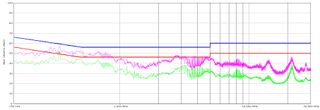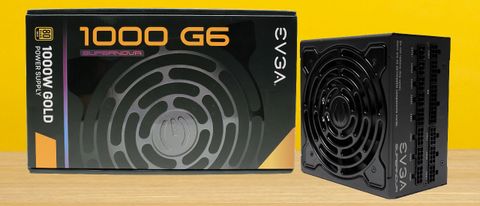Why you can trust Tom's Hardware
Advanced Transient Response Tests
For details about our transient response testing, please click here.
In the real world, power supplies are always working with loads that change. It's of immense importance, then, for the PSU to keep its rails within the ATX specification's defined ranges. The smaller the deviations, the more stable your PC will be, with less stress applied to its components.
We should note that the ATX spec requires capacitive loading during the transient rests, but in our methodology, we also choose to apply a worst case scenario with no additional capacitance on the rails.
Advanced Transient Response at 20% – 20ms
| Voltage | Before | After | Change | Pass/Fail |
| 12V | 12.17V | 12.00V | 1.41% | Pass |
| 5V | 5.01V | 4.91V | 1.94% | Pass |
| 3.3V | 3.33V | 3.20V | 3.87% | Pass |
| 5VSB | 5.06V | 5.02V | 0.74% | Pass |
Advanced Transient Response at 20% – 10ms
| Voltage | Before | After | Change | Pass/Fail |
| 12V | 12.17V | 12.01V | 1.34% | Pass |
| 5V | 5.01V | 4.91V | 2.02% | Pass |
| 3.3V | 3.33V | 3.20V | 3.82% | Pass |
| 5VSB | 5.06V | 5.00V | 1.02% | Pass |
Advanced Transient Response at 20% – 1ms
| Voltage | Before | After | Change | Pass/Fail |
| 12V | 12.17V | 12.00V | 1.44% | Pass |
| 5V | 5.01V | 4.92V | 1.88% | Pass |
| 3.3V | 3.33V | 3.20V | 3.76% | Pass |
| 5VSB | 5.06V | 5.01V | 0.88% | Pass |
Advanced Transient Response at 50% – 20ms
| Voltage | Before | After | Change | Pass/Fail |
| 12V | 12.13V | 12.02V | 0.95% | Pass |
| 5V | 5.00V | 4.80V | 3.93% | Pass |
| 3.3V | 3.31V | 3.18V | 4.06% | Pass |
| 5VSB | 5.02V | 4.98V | 0.81% | Fail |
Advanced Transient Response at 50% – 10ms
| Voltage | Before | After | Change | Pass/Fail |
| 12V | 12.13V | 12.03V | 0.87% | Pass |
| 5V | 5.00V | 4.89V | 2.13% | Pass |
| 3.3V | 3.31V | 3.18V | 4.00% | Pass |
| 5VSB | 5.02V | 4.97V | 1.07% | Fail |
Advanced Transient Response at 50% – 1ms
| Voltage | Before | After | Change | Pass/Fail |
| 12V | 12.13V | 12.03V | 0.86% | Pass |
| 5V | 5.00V | 4.89V | 2.12% | Pass |
| 3.3V | 3.31V | 3.18V | 3.95% | Pass |
| 5VSB | 5.02V | 4.97V | 0.92% | Fail |

Results 25-29: Transient Response







The 1000 G6 unit cannot meet the performance levels of the similar capacity G3 model, and it also stays behind the Corsair RM1000x (2021) in transient response on all rails but 5VSB. All in all, the transient response is satisfactory but definitely not among the best in this category.
Turn-On Transient Tests
In the next set of tests, we measure the PSU's response in simpler transient load scenarios—during its power-on phase. Ideally, we don't want to see any voltage overshoots or spikes since those put a lot of stress on the DC-DC converters of installed components.

Turn-On Transient Response Scope Shots


There is only a tiny voltage overshoot at 5VSB, which is nothing to worry about.
Power Supply Timing Tests
There are several signals generated by the power supply, which need to be within specified, by the ATX spec, ranges. If they are not, there can be compatibility issues with other system parts, especially mainboards. From year 2020, the PSU's Power-on time (T1) has to be lower than 150ms and the PWR_OK delay (T3) from 100 to 150ms, to be compatible with the Alternative Sleep Mode.
| T1 (Power-on time) & T3 (PWR_OK delay) | ||
|---|---|---|
| Load | T1 | T3 |
| 20% | 89.5ms | 130ms |
| 100% | 90ms | 131ms |
The PWR_OK delay is within the 100-150ms region, so the PSU supports the alternative sleep mode recommended by the ATX spec.
Ripple Measurements
Ripple represents the AC fluctuations (periodic) and noise (random) found in the PSU's DC rails. This phenomenon significantly decreases the capacitors' lifespan because it causes them to run hotter. A 10-degree Celsius increase can cut into a cap's useful life by 50%. Ripple also plays an important role in overall system stability, especially when overclocking is involved.
The ripple limits, according to the ATX specification, are 120mV (+12V) and 50mV (5V, 3.3V, and 5VSB).
| Test | 12V | 5V | 3.3V | 5VSB | Pass/Fail |
| 10% | 9.04mV | 5.06mV | 4.45mV | 6.58mV | Pass |
| 20% | 4.34mV | 4.6mV | 3.94mV | 7.29mV | Pass |
| 30% | 6.38mV | 5.27mV | 4.35mV | 7.75mV | Pass |
| 40% | 6.03mV | 6.19mV | 4.66mV | 8.51mV | Pass |
| 50% | 6.95mV | 7.98mV | 6.04mV | 10.6mV | Pass |
| 60% | 7.46mV | 8.54mV | 6.45mV | 10.25mV | Pass |
| 70% | 8.63mV | 8.8mV | 6.09mV | 13.56mV | Pass |
| 80% | 7.81mV | 8.74mV | 10.75mV | 13.72mV | Pass |
| 90% | 9.66mV | 9.82mV | 12.18mV | 12.54mV | Pass |
| 100% | 12.05mV | 12.41mV | 14.69mV | 14.12mV | Pass |
| 110% | 12.98mV | 15.51mV | 15.86mV | 14.75mV | Pass |
| CL1 | 11.18mV | 7.56mV | 12.44mV | 7.42mV | Pass |
| CL2 | 6.39mV | 7.17mV | 4.69mV | 7.61mV | Pass |
| CL3 | 8.96mV | 5.4mV | 14.53mV | 7.77mV | Pass |
| CL4 | 11.51mV | 10.94mV | 9.33mV | 13.88mV | Pass |

Results 30-33: Ripple Suppression



Ripple suppression is excellent, on all rails!
Ripple At Full Load

Ripple Full Load Scope Shots



Ripple At 110% Load

Ripple 110% Load Scope Shots



Ripple At Cross-Load 1

Ripple CL1 Load Scope Shots



Ripple At Cross-Load 2

Ripple CL2 Load Scope Shots



EMC Pre-Compliance Testing – Average & Quasi-Peak EMI Detector Results
Electromagnetic Compatibility (EMC) is the ability of a device to operate properly in its environment without disrupting the proper operation of other nearby devices.
Electromagnetic Interference (EMI) stands for the electromagnetic energy a device emits, and it can cause problems in other nearby devices if too high. For example, it can be the cause of increased static noise in your headphones and/or speakers.

One spur exceeds the limits with the average detector, but everything is fine with the peak detector. EMI emissions are kept bottom low in most frequencies.
MORE: Best Power Supplies
MORE: How We Test Power Supplies
MORE: All Power Supply Content
Current page: Transient Response Tests, Timing Tests, Ripple Measurements and EMC Pre-Compliance Testing
Prev Page Protection Features, DC Power Sequencing, Cross-Load Tests and Infrared Images Next Page Performance, Noise, Efficiency and Power FactorAris Mpitziopoulos is a Contributing Editor at Tom's Hardware US, covering PSUs.
-
Roland Of Gilead Hey there,Reply
Shouldn't the '1000w' in the Power specification chart be underneath the 12v rail? Also, are the amps correct? Specs from EVGA state 83.3a on the 12v rail, as opposed to 62.5? -
jsz031 Why is EVGA so scared to send you a GT or GA?Reply
I know they're worse, but I would like to see how they relatively perform according to your specific linear testing. -
werther595 Is the Super Flower models in the comparison charts the Leadex V Pro 1000W? I think that is their only current 1000W Gold unit. It was specifically named in the review of the Corsair 2021 PSU. Will you be reviewing the Super flower Leadex V Pro?Reply -
Lemkes Compared with the 1000 G3, the G6 model with a similar capacity has a depth of 140mm and a smaller size. A 135mm fan can hardly fit its chassis. As we said before, EVGA's G6 model uses an upgraded version of the Seasonic Focus platform.Reply
targetpayandbenefits.com -
LordTimothyDexter There's no way this review looked at the fan curve for this and must have taken the average dB data from somewhere else. The low average dB is EXTREMELY misleading for this PSU. It stay quiet up to a certain power draw and then the noise SKYROCKETS from it jumping to extremely high fan speeds, but if you were to take the mean dB across its load % it would show a low average dB. Very misleading, this thing gets louder than all the fans in my case combined -- 13 Arctic fans going at 1300-1500rpm are drowned out by the volume from this PSUReply
